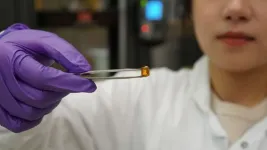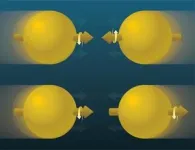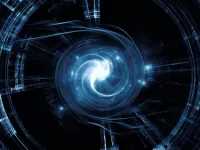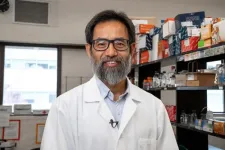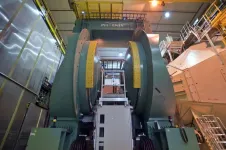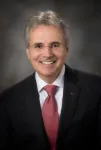(Press-News.org) A gel that combines both stiffness and toughness is a step forward in the bid to create biodegradable implants for joint injuries, according to new UBC research.
Mimicking articular cartilage, found in our knee and hip joints, is challenging. This cartilage is key to smooth joint movement, and damage to it can cause pain, reduce function, and lead to arthritis. One potential solution is to implant artificial scaffolds made of proteins that help the cartilage regenerate itself as the scaffold biodegrades. How well the cartilage regenerates is linked to how well a scaffold can mimic the biological properties of cartilage, and to date, researchers have struggled to combine the seemingly incompatible properties of stiffness and toughness.
Now, new research by Canadian and Chinese scientists published today in Nature outlines a method to marry these properties in a biodegradable gel. “Cartilage is tricky,” says senior author Dr. Hongbin Li, a professor in the UBC department of chemistry. “Articular cartilage repair represents an important medical challenge because naturally speaking, it doesn’t repair itself.
Biodegradable cartilage implants must strike a delicate balance in that they need to be both stiff and tough, like actual cartilage. Mechanically, when something is stiff, it resists being bent or deformed, but that usually means it’s brittle - when you bend it, it breaks, like glass. When something is tough, it resists breaking, even when you bend it, but it might be too soft to be useful in a joint, like jelly, or even just softer than actual cartilage. That’s the case with current implants that are made from proteins, which creates a mismatch between what the cells need and what’s being provided, says Dr. Li. This leads to the cartilage not repairing as well as it could.
In the study, Dr. Li and his team developed a new approach to stiffen a protein gel without sacrificing toughness, by physically tangling together the chains of a particular protein that made up the gel’s network. “These entangled chains can move, which allows energy, for instance, the impact from jumping, to be dissipated, just like shock absorbers in bikes. In addition, we combined this with an existing method of folding and unfolding proteins, which also allows for energy dissipation,” says first author Dr. Linglan Fu, who conducted the research as a doctoral student at UBC’s department of chemistry.
The resulting gel was super tough, able to resist slicing with a scalpel, and was more stiff than other protein hydrogels. Its ability to resist compression was among the highest achieved by any such gels and compared favorably with actual articular cartilage. And the gel was able to rapidly recover its original shape after compression, as real cartilage does after jumping.
Rabbits implanted with the gel showed notable signs of repair of articular cartilage 12 weeks after implantation, with no hydrogel remaining and no rejection of the implant by the animals’ immune system. The researchers observed bone tissue growth similar to the existing tissue, and regenerated tissue close to existing cartilage for the gel implant group—much better results than they saw with a control group.
Interestingly, a stiffer version of the gel had better results than a softer version, likely due to the higher stiffness being more compatible with bone and cartilage tissues, and so providing a physical cue to the body for effective regeneration. However, there can be such a thing as too stiff: the stiffest gel did not work as well, likely due to its slower degradation in the body, the researchers said. “This just shows how complex this area of research is, and the need to take into account the many different physical and biochemical cues and factors when designing these scaffolds,” says co-author Dr. Qing Jiang, a professor and surgeon at Nanjing University.
Further animal testing is needed and the research is still premature for human trials. The researchers’ next steps include this testing, fine-tuning the current gel composition and adding additional biochemical cues to further promote cell regeneration. “By optimizing both biochemical and biomechanical cues together, we will see in the future whether these new scaffolds can lead to even better outcomes,” Dr. Li says.
END
Biodegradable gel shows promise for cartilage regeneration
2023-06-21
ELSE PRESS RELEASES FROM THIS DATE:
New study in Nature Water demonstrates a vastly more sustainable, cost-effective method to desalinate industrial wastewater
2023-06-21
Vanderbilt researchers are part of a team that has developed a cutting-edge method that seeks to make the removal of salt from hypersaline industrial wastewater far more energy-efficient and cost-effective.
While desalination through reverse osmosis has made tremendous strides—allowing for salt removal from seawater for less than a penny per gallon—it still falls short in eliminating saline in wastewater from industries like mining, oil and gas and power generation and in inland brackish water. The industrial brines are currently injected into deep geological formations or transferred to a evaporation ponds, and both disposal methods are facing more regulatory and ...
Researchers reveal mechanism of protection against breast and ovarian cancer
2023-06-21
In a new paper published today in Nature, researchers at the Francis Crick Institute have outlined the structure and function of a protein complex which is required to repair damaged DNA and protect against cancer.
Every time a cell replicates, mistakes can happen in the form of mutations, but specialised proteins exist to repair the damaged DNA.
People with mutations in a DNA repair protein called BRCA2 are predisposed to breast, ovarian and prostate cancers, which often develop at a young age. In the clinic, these cancers are treated with a drug that inhibits PARP, ...
Atoms realize a Laughlin state
2023-06-21
The discovery of the quantum Hall effects in the 1980's revealed the existence of novel states of matter called "Laughlin states", in honor of the American Nobel prize winner who successfully characterized them theoretically. These exotic states specifically emerge in 2D materials, at very low temperature and in the presence of an extremely strong magnetic field. In a Laughlin state, electrons form a peculiar liquid, where each electron dances around its congeners while avoiding them as much as possible. Exciting such a quantum liquid generates collective states that physicists associate to fictitious particles, whose ...
Ovarian cancer study identifies key genes for potential treatments
2023-06-21
New research is increasing our understanding about why some women with the most lethal form of ovarian cancer respond much better to treatment than others.
Researchers at Imperial College London have confirmed that the tumours of some women with high-grade serious ovarian cancer (HGSOC) contain a type of lymphoid tissue – known as tertiary lymphoid structures, or TLS – and that the presence of this tissue gives women a significantly better prognosis. They have also identified genes in HGSOC ...
Detection of an echo emitted by our Galaxy's black hole 200 years ago
2023-06-21
An international team of scientists has discovered that Sagittarius A* (Sgr A*)1, the supermassive black hole at the centre of the Milky Way, emerged from a long period of dormancy some 200 years ago. The team, led by Frédéric Marin2, a CNRS researcher at the Astronomical Strasbourg Observatory (CNRS/University of Strasbourg), has revealed the past awakening of this gigantic object, which is four million times more massive than the Sun. Their work is published in Nature on 21 June. Over a period of one year at the beginning of the 19th century, the black ...
Study hints at how cancer immunotherapy can be safer
2023-06-21
New Haven, Conn. — Cancer immunotherapy has revolutionized treatment of many forms of cancer by unleashing the immune system response against tumors. Immunotherapies that block checkpoint receptors like PD-1, proteins that limit the capacity of T cells to attack tumors, have become the choice for the treatment of numerous types of solid cancer.
However, the introduction of PD-1-blocking agents can often result in T cells attacking healthy tissues in addition to cancer cells, causing severe, sometimes life-threatening, side effects that can blunt the benefits of immunotherapy.
A new study published by researchers ...
Drug-resistant fungi are thriving in even the most remote regions of Earth
2023-06-21
New McMaster research has found that a disease-causing fungus — collected from one of the most remote regions in the world — is resistant to a common antifungal medicine used to treat infections.
The study, published today in mSphere, showed that seven per cent of Aspergillus fumigatus samples collected from the Three Parallel Rivers region in Yunnan, China were drug resistant.
Perched 6,000 metres above sea level and guarded by the staggering glaciated peaks of the Eastern Himalayas, the region is sparsely populated and undeveloped, which makes the presence of antimicrobial-resistant strains of A. fumigatus all the more striking for Jianping Xu, ...
Direct photons point to positive gluon polarization
2023-06-21
UPTON, NY— A new publication by the PHENIX Collaboration at the Relativistic Heavy Ion Collider (RHIC) provides definitive evidence that gluon “spins” are aligned in the same direction as the spin of the proton they’re in. The result, just published in Physical Review Letters, provides theorists with new input for calculating how much gluons—the gluelike particles that hold quarks together within protons and neutrons—contribute to a proton’s ...
Mutant KRAS regulates Y chromosome gene in colorectal cancer, driving metastasis and inhibiting anti-tumor immunity
2023-06-21
HOUSTON ― Researchers at The University of Texas MD Anderson Cancer Center have uncovered a gene on the Y chromosome that is upregulated in KRAS-mutated colorectal cancer (CRC), increasing tumor cell invasiveness and reducing anti-tumor immunity in male patients.
The preclinical study, published today in Nature, provides novel insights into the longstanding mystery of molecular and cellular mechanisms that drive increased metastasis and poor prognosis in men with CRC. The results highlight the Y chromosome gene KDM5D, which codes for an epigenetic enzyme, as a potential therapeutic target and uncover ...
Conservation policies risk damaging global biodiversity, researchers argue
2023-06-21
‘Green’ farming policies may accelerate global biodiversity loss, two leading academics have warned.
Rewilding, organic farming and the ‘nature friendly farming’ measures included in some government conservation policies risk worsening the global biodiversity crisis by reducing how much food is produced in a region, driving up food imports and increasing environmental damage overseas.
In an article published today in the journal Nature, Professor Ian Bateman of the University of Exeter and Professor Andrew Balmford of the University of Cambridge urge policy-makers to consider a bolder approach known as ...
